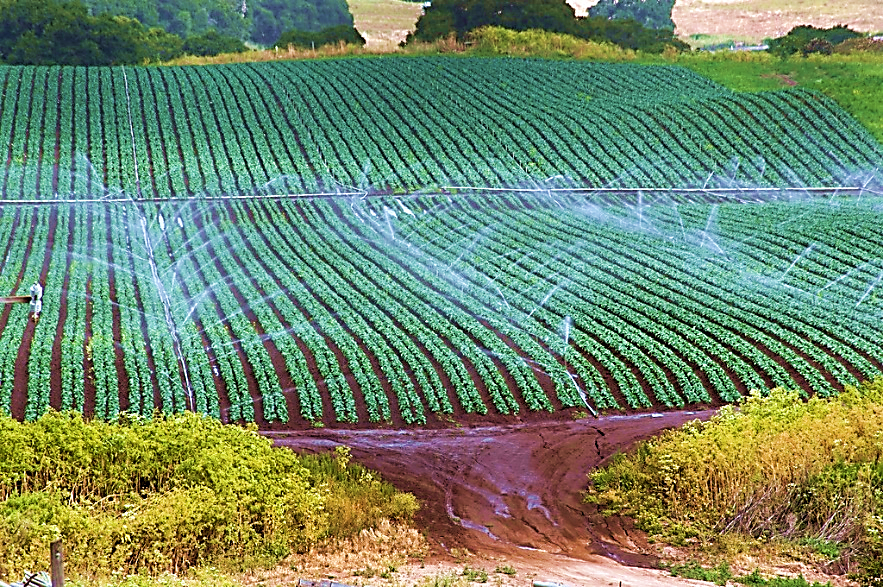
Which method of irrigation is cheaper but less efficient?
- A. Traditional method
B. Modern method
C. Both A and B
D. None of these
- A. Traditional method
Answer
487.5k+ views
Hint: Modern irrigation methods involve high inputs and provide better crop yield and less water loss than the older traditional methods such as the pulley system, chain system, and lever system.
Step by step answer:An artificial process of applying water to the crops to fulfill their water requirements is known as irrigation. Various nutrients can also be provided through the process of irrigation. Some common sources of irrigation are ponds, wells, lakes, canals, tube-wells, and dams. Different types of irrigation methods are used for improving crop yields. The types of irrigation methods depend upon types of soils, crops, climates, and resources. Different types of irrigation include- surface, localized, sprinkler, drip, center pivot, manual, and sub-irrigation. The methods of irrigation are of two types-
1. Traditional methods- They are done manually in which the canals are pulled by the farmers using cattle and carried to the crop fields. Its efficiency is poor because of the uneven distribution of the water. The water loss is very high. Some common examples of traditional methods are- pulley system, chain pump, and lever system.
2. Modern methods-These methods compensate for the disadvantages of traditional methods. It involves two systems- sprinkler and drip system.
Traditional methods are cheaper as compared to modern methods and are less efficient.

Hence option A is correct.
Note: Irrigation is the process of supplying water to the crops at different time intervals. It helps in providing moisture, that is required for various plant processes such as growth and development, germination, and other related processes. The frequency, rate, and amount of time vary with different crops and also depends upon the types of soils.
Step by step answer:An artificial process of applying water to the crops to fulfill their water requirements is known as irrigation. Various nutrients can also be provided through the process of irrigation. Some common sources of irrigation are ponds, wells, lakes, canals, tube-wells, and dams. Different types of irrigation methods are used for improving crop yields. The types of irrigation methods depend upon types of soils, crops, climates, and resources. Different types of irrigation include- surface, localized, sprinkler, drip, center pivot, manual, and sub-irrigation. The methods of irrigation are of two types-
1. Traditional methods- They are done manually in which the canals are pulled by the farmers using cattle and carried to the crop fields. Its efficiency is poor because of the uneven distribution of the water. The water loss is very high. Some common examples of traditional methods are- pulley system, chain pump, and lever system.
2. Modern methods-These methods compensate for the disadvantages of traditional methods. It involves two systems- sprinkler and drip system.
Traditional methods are cheaper as compared to modern methods and are less efficient.

Hence option A is correct.
Note: Irrigation is the process of supplying water to the crops at different time intervals. It helps in providing moisture, that is required for various plant processes such as growth and development, germination, and other related processes. The frequency, rate, and amount of time vary with different crops and also depends upon the types of soils.
Recently Updated Pages
Master Class 12 Social Science: Engaging Questions & Answers for Success

Class 12 Question and Answer - Your Ultimate Solutions Guide

Class 10 Question and Answer - Your Ultimate Solutions Guide

Master Class 10 Science: Engaging Questions & Answers for Success

Master Class 10 Maths: Engaging Questions & Answers for Success

Master Class 9 General Knowledge: Engaging Questions & Answers for Success

Trending doubts
When Sambhaji Maharaj died a 11 February 1689 b 11 class 8 social science CBSE

How many ounces are in 500 mL class 8 maths CBSE

Advantages and disadvantages of science

Write the smallest number divisible by both 306 and class 8 maths CBSE

In Indian rupees 1 trillion is equal to how many c class 8 maths CBSE

What led to the incident of Bloody Sunday in Russia class 8 social science CBSE




